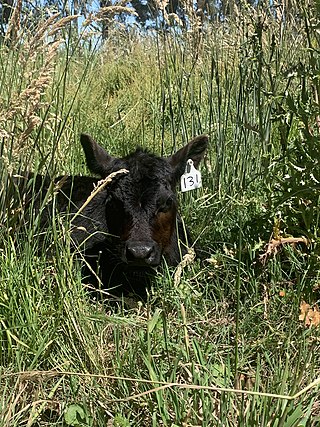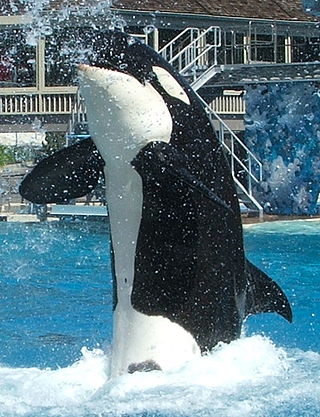Related Research Articles

A calf is a young domestic cow or bull. Calves are reared to become adult cattle or are slaughtered for their meat, called veal, and their hide.

Whales are a widely distributed and diverse group of fully aquatic placental marine mammals. As an informal and colloquial grouping, they correspond to large members of the infraorder Cetacea, i.e. all cetaceans apart from dolphins and porpoises. Dolphins and porpoises may be considered whales from a formal, cladistic perspective. Whales, dolphins and porpoises belong to the order Cetartiodactyla, which consists of even-toed ungulates. Their closest non-cetacean living relatives are the hippopotamuses, from which they and other cetaceans diverged about 54 million years ago. The two parvorders of whales, baleen whales (Mysticeti) and toothed whales (Odontoceti), are thought to have had their last common ancestor around 34 million years ago. Mysticetes include four extant (living) families: Balaenopteridae, Balaenidae, Cetotheriidae, and Eschrichtiidae. Odontocetes include the Monodontidae, Physeteridae, Kogiidae, and Ziphiidae, as well as the six families of dolphins and porpoises which are not considered whales in the informal sense.

The beluga whale is an Arctic and sub-Arctic cetacean. It is one of two members of the family Monodontidae, along with the narwhal, and the only member of the genus Delphinapterus. It is also known as the white whale, as it is the only cetacean to regularly occur with this colour; the sea canary, due to its high-pitched calls; and the melonhead, though that more commonly refers to the melon-headed whale, which is an oceanic dolphin.

Weaning is the process of gradually introducing an infant human or another mammal to what will be its adult diet while withdrawing the supply of its mother's milk.

Shedd Aquarium is an indoor public aquarium in Chicago. Opened on May 30, 1930, the 5 million US gal aquarium holds about 32,000 animals and is the third largest aquarium in the Western Hemisphere, after the Georgia Aquarium and Monterey Bay Aquarium.

Georgia Aquarium is a public aquarium in Atlanta, Georgia, United States. It exhibits hundreds of species and thousands of animals across its seven major galleries, all of which reside in more than 11 million US gallons (42,000 m3) of water. It was the largest aquarium in the world from its opening in 2005 until 2012 when it was surpassed by the S.E.A. Aquarium in Singapore and the Chimelong Ocean Kingdom in China; the Georgia Aquarium remains the largest aquarium in the United States and the fourth largest in the world.

Point Defiance Zoo & Aquarium (PDZA) is the only combined zoo and aquarium in the Pacific Northwest, located in Tacoma, Washington, US, owned by Metro Parks Tacoma. Situated on 29 acres (12 ha) in Tacoma's Point Defiance Park, the zoo and aquarium are home to over 9,000 specimens representing 367 animal species. The zoo was founded in 1905; the aquarium was founded in 1935 near Commencement Bay and relocated within the zoo in 1963. Both are accredited by the Association of Zoos and Aquariums. In Pierce County, Washington, this is said to be one of the most popular tourist destinations, bringing in over more than 600,000 visitors per year.

The Vancouver Aquarium is a public aquarium located in Stanley Park in Vancouver, British Columbia, Canada. In addition to being a major tourist attraction for Vancouver, the aquarium is a centre for marine research, ocean literacy education, climate activism, conservation and marine animal rehabilitation.

Marineland, is a themed zoo and amusement park in Niagara Falls, Ontario, Canada. The park has performing marine animal shows, exhibits of marine and land animals, and amusement rides. It keeps dolphins, sea lions, and beluga whales. Until 2023, the park also kept walruses and orcas. The park also keeps bears, deer, and other land animals. It was founded and operated by John Holer, a Slovenian immigrant, from 1961 until his death in 2018. It is privately owned and operated by his family.

The Minnesota Zoo, is an AZA-accredited zoo in Apple Valley, Minnesota. The zoo is one of two state-supported zoos in the United States, with the other being the North Carolina Zoo. When it opened on May 22, 1978 it was fairly revolutionary in its exhibit design. The zoo, built in a suburbanizing rural area, had more space to house exhibits and was one of the first zoos to organize its animals by their living environment as opposed to their species.
Sealand of the Pacific was a public aquarium in South Oak Bay at The Oak Bay Marina, near the city of Victoria, in British Columbia, Canada. It housed a number of orcas: Haida, Nootka, and Tilikum. In 1991, all three were involved in an incident in which a trainer, Keltie Byrne, was killed. The aquarium subsequently closed and sold its orcas to SeaWorld.

SeaWorld San Antonio is a 416-acre (168 ha) marine mammal park, oceanarium and animal theme park in the Westover Hills District of San Antonio, Texas, on the city's west side. It is the largest of the three parks in the SeaWorld chain owned and operated by United Parks & Resorts. As North America's largest marine-life theme park, and one of the world's largest marine-life theme parks, it is focused on conservation, education and animal rescue. It is a member of the Alliance of Marine Mammal Parks and Aquariums (AMMPA) and is accredited by the Association of Zoos and Aquariums (AZA).
Mystic Aquarium is a marine aquarium in Mystic, Connecticut. It is one of only two U.S. facilities holding Steller sea lions, and it has the only beluga whales in New England. Special exhibits include the largest outdoor beluga whale habitat in the United States, a ray and shark touch pool, an African penguin exhibit, a jelly gallery, and the new Dino Seas: An Immersive Journey exhibit. The aquarium is a member of the Alliance of Marine Mammal Parks and Aquariums (AMMPA) and is an accredited member of the Association of Zoos and Aquariums (AZA). It is a subsidiary of the Sea Research Foundation, Inc.
Bubba was a giant grouper that resided at the Shedd Aquarium in Chicago, Illinois. Bubba is believed to be the first fish to undergo chemotherapy. He was often nicknamed "The Super Grouper".

A public aquarium (pl. aquaria) or public water zoo is the aquatic counterpart of a zoo, which houses living aquatic animal and plant specimens for public viewing. Most public aquariums feature tanks larger than those kept by home aquarists, as well as smaller tanks.

Springer, officially named A73, is a wild orca from the Northern Resident Community of orcas, which frequents the waters off the northern part of Vancouver Island every summer. In January 2002, Springer, then a calf developmentally equivalent to a human toddler, was discovered alone and emaciated some 250 miles from the territory of her family. Experts identified Springer by her vocal calls that are specific to her family, or "pod," and by examining photographs of her eye patch. They were also able to determine where Springer's pod was currently located.

Dozens of orcas are held in captivity for breeding or performance purposes. The practice of capturing and displaying orcas in exhibitions began in the 1960s, and they soon became popular attractions at public aquariums and aquatic theme parks due to their intelligence, trainability, striking appearance, playfulness, and sheer size. As of 24 March 2024, around 55 orcas are in captivity worldwide, 33 of which were captive-born. At that time, there were 18 orcas in the SeaWorld parks.

The Port of Nagoya Public Aquarium is a public aquarium in Minato-ku, Nagoya, Aichi Prefecture, Japan.
Tahlequah, also known as J35, is a killer whale of the southern resident community in the northeastern Pacific Ocean. She has given birth to three known offspring, a male (Notch) in 2010, a female (Tali) in 2018, and another male (Phoenix) in 2020. Her second calf, Tali, died shortly after birth and J35 carried her body for 17 days in an apparent show of grief that attracted international attention.
References
- 1 2 3 4 Mullen, William (July 14, 2001). "Beluga buddies are an odd couple". Chicago Tribune. Retrieved 2011-10-29.
- 1 2 "Meet the Belugas". Shedd Aquarium. Retrieved 26 January 2022.
- 1 2 3 Mullen, William (5 January 2005). "Raising beluga orphan challenged aquarium staff". Seattle Times. Retrieved 26 January 2022.
- ↑ Mullen, William (5 November 1999). "BELUGA WHALE AT SHEDD IS UNEXPECTEDLY EXPECTING". Chicago Tribune. Retrieved 26 January 2022.
- ↑ "Young beluga flies to Tacoma". The Spokesman Review. 11 June 2007. Retrieved 26 January 2022.